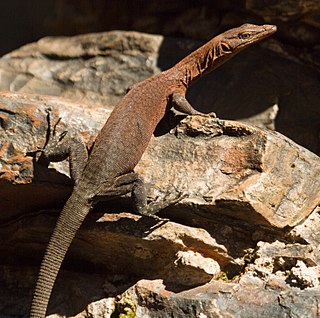
Gehyra is a genus of geckos in the family Gekkonidae. They are known as web-toed geckos or dtellas, and most species within the genus bear close resemblance to geckos from the genus Hemidactylus.

Crenadactylus ocellatus, also known as the southwestern clawless gecko or western clawless gecko, is the smallest species of nocturnal Gekkonidae (gecko) found in Australia.

Underwoodisaurus is a small genus of Australian lizards in the family Carphodactylidae. Member species are commonly known as thick-tailed geckos, along with the species Uvidicolus sphyrurus.

Crenadactylus, the clawless geckos, are named for their distinguishing feature, the absence of terminal claws on the digits. They are the only Australian members of Gekkonidae to lack claws, the endemic genus is also the smallest in size.

The Diplodactylidae are a family in the suborder Gekkota (geckos), with over 150 species in 25 genera. These geckos occur in Australia, New Zealand, and New Caledonia. Diplodactylids are the most ecologically diverse and widespread family of geckos in both Australia and New Caledonia, and are the only family of geckos found in New Zealand. Three diplodactylid genera have recently been split into multiple new genera.

The Southern Pilbara rock goanna, also known as the Hamersley Range rock monitor, is a dwarf member of the family Varanidae.

Lucasium stenodactylum, also known as the crowned gecko or pale-snouted ground gecko, is a species of gecko from Australia.
The Pilbara rock monitor is a small member of the family Varanidae endemic to the Chichester Range in North West Australia.
Diplodactylus savagei, known commonly as the yellow-spotted Pilbara gecko, is a species of lizard in the family Diplodactylidae. The species is endemic to Australia.
The Pilbara ground gecko also known commonly as Wombey's gecko, is a species of lizard in the family Diplodactylidae. The species is endemic to Australia.

The Eyre Basin beaked gecko is a gecko endemic to Australia in the family Diplodactylidae. It is found throughout parts of South Australia, Queensland and the Northern Territory and New South Wales.
Gehyra kimberleyi, also known commonly as the Kimberley dtella or the robust termitaria gecko, is a species of gecko, a lizard in the family Gekkonidae. The species is endemic to western Australia.

The black Pilbara gecko is a species of gecko. It is endemic to Australia.

Heteronotia spelea, also known as Pilbara cave gecko, cave prickly gecko, or desert cave gecko, is a species of gecko. It is endemic to Australia.
Crenadactylus horni, the Central Uplands clawless gecko, is a species of gecko endemic to the central desert region of Australia.
Crenadactylus occidentalis, also called the western clawless gecko, is a species of gecko endemic to the western coast of Australia.
The Southwest Kimberley clawless gecko is a species of gecko endemic to Western Australia in Australia.
The Cape Range clawless gecko is a species of gecko endemic to Western Australia in Australia.

The Pilbara crevice-skink is a species of large skink, a lizard in the family Scincidae. The species is native to western Australia.
The ghost skink is a species of skink endemic to Australia. Commonly known as the Ghost skink because of its faded dorsolateral banding when compared to other banded Erimiascincus species that have well-defined dorsolateral banding on their backs.










